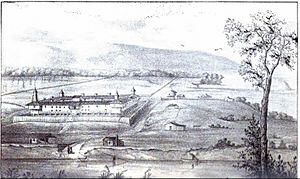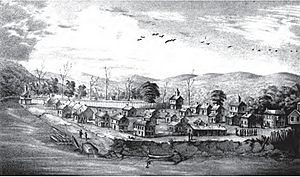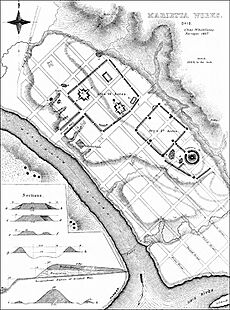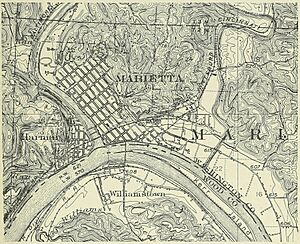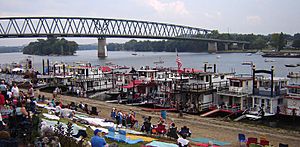Marietta, Ohio facts for kids
Quick facts for kids
Marietta, Ohio
|
|
|---|---|
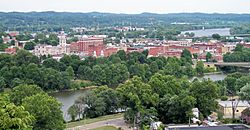
Downtown Marietta, with Muskingum River in foreground, and Ohio River in background right
|
|
| Country | United States |
| State | Ohio |
| County | Washington |
| Settled | April 7, 1788 |
| Incorporated | December 2, 1800 |
| Named for | Marie Antoinette |
| Government | |
| • Type | Mayor-council |
| Area | |
| • Total | 8.75 sq mi (22.66 km2) |
| • Land | 8.43 sq mi (21.83 km2) |
| • Water | 0.32 sq mi (0.83 km2) |
| Elevation | 653 ft (199 m) |
| Population
(2020)
|
|
| • Total | 13,385 |
| • Density | 1,587.97/sq mi (613.10/km2) |
| Time zone | UTC-5 (Eastern (EST)) |
| • Summer (DST) | UTC-4 (EDT) |
| ZIP code |
45750
|
| Area code(s) | 740, 220 |
| FIPS code | 39-47628 |
| GNIS feature ID | 1087138 |
| Website | http://www.mariettaoh.net/ |
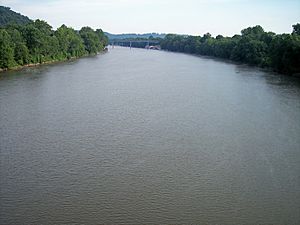
Marietta is a city in southeastern Ohio, United States. It is the main city of Washington County, Ohio, where the county government is located. Marietta sits where the Muskingum River and Ohio River meet. It is about 11 miles (18 km) northeast of Parkersburg, West Virginia. In 2020, about 13,385 people lived in Marietta.
Marietta was founded in 1788 by pioneers. It was the first permanent U.S. settlement in the Northwest Territory. This territory was created in 1787 and later became the state of Ohio. The city is named after Marie Antoinette, who was the Queen of France at the time. This honored France's help during the American Revolution.
Before the settlers arrived, Native American groups lived in the area. These groups, part of the Hopewell tradition, built large earthworks over 1,500 years ago. The first settlers saved some of these ancient structures, like the Great Mound, in parks such as Mound Cemetery. Since 1835, Marietta has been home to Marietta College, a private school with about 1,200 students. Before the American Civil War, Marietta was also a stop on the Underground Railroad, helping enslaved people find freedom.
Contents
History of Marietta
Ancient Cultures and Earthworks
For thousands of years, different Native American groups lived along the Ohio River. Many of these groups built large earth mounds. These mounds often showed their beliefs about the world and were sometimes linked to stars.
Between 100 BC and AD 500, the Hopewell culture built a large group of earthworks. These are now known as the Marietta Earthworks. They were built on a flat area near where the Muskingum River meets the Ohio River. The complex included a large square area with four flat-topped mounds. These mounds were likely used for ceremonies. There was also a large round mound used for burials. A special path led from the earthworks to the river. By the time later tribes like the Shawnee lived there, the original purpose of these mounds was unknown.
Early European Settlement
French explorers came to this area in the 1700s. They buried lead plates to claim the land for France. Later, France gave this land to Great Britain after the French and Indian War. Two of these French plates were found near Marietta in 1798. A monument was built in the 1900s to remember this French history.
In 1770, George Washington, who would later become a U.S. president, explored lands west of Virginia. During the American Revolutionary War, Washington told his friend General Rufus Putnam about the beautiful Ohio Valley. He shared his ideas for settling the area. In 1781, John Carpenter built Carpenter's Fort, a protected house near present-day Marietta.
After the Revolutionary War, the U.S. government needed to develop its new lands. It decided to pay war veterans with land in the Northwest Territory. This territory was set up in 1787 by the Northwest Ordinance. Arthur St. Clair became the first governor of this new territory.
The Ohio Company of Associates bought a large amount of land from Congress. On April 7, 1788, 48 men from this company, led by General Putnam, arrived at the meeting point of the Muskingum and Ohio rivers. This spot was across from Fort Harmar, a military base built three years earlier.
These settlers brought the first U.S. government to the area. They created the first permanent U.S. settlement in the Northwest Territory. They named it Marietta to honor Marie Antoinette, the Queen of France. France had helped the American colonies win their independence.
The settlers quickly built two forts: Campus Martius and Picketed Point Stockade. They also started planning their new community. In 1788, George Washington praised the new settlement, saying it had "favorable auspices." By the end of 1788, 137 people lived in Marietta.
In 1789, the U.S. signed the Treaty of Fort Harmar with several Native American tribes. This treaty aimed to settle land and trade issues. However, conflicts grew as American settlers moved onto Native American lands. After years of fighting, the Native Americans were defeated. The Treaty of Greenville (1795) was signed, which made it safer for settlers to leave the forts and build farms.
The settlers valued education. They started a school for children at Campus Martius during their first winter. In 1797, they founded Muskingum Academy. Many people in Marietta were against slavery. In 1802, Ephraim Cutler helped Ohio become a state free of slavery.
Marietta in the 1800s
Marietta College was officially started in 1835. It became a stop on the Underground Railroad, helping enslaved people escape to freedom from the South.
The settlers protected the Great Mound, or Conus, by building their cemetery around it. They also saved two other large mounds. One of these, called Capitolinus, later became the site for the city library. By 1900, Mound Cemetery had the most Revolutionary War officers buried in any cemetery in the country.
Marietta's location on two major rivers was perfect for businesses. Boat building was an early industry. Workers built large ships that sailed down the Mississippi River to the Gulf of Mexico. Later, steamboats were also built here. Factories made bricks and sawmills provided wood for buildings. An iron mill and foundries made rails for the growing railroad industry. The Marietta Chair Factory made furniture.
People remained interested in the ancient earthworks. In 1848, a detailed survey of the Marietta Earthworks was published. This survey showed the original layout of the complex, which included squares, mounds, and a path to the river. Sadly, this path was destroyed in 1843 as the city grew.
Railroads and Oil Boom
Railroads began to connect Marietta to other places. The Marietta and Cincinnati Railroad started building tracks in 1851. The first train from Cincinnati arrived in Marietta on April 9, 1857. Over time, different railroad companies bought and connected tracks.
In 1860, oil was discovered near Marietta. Oil booms in 1875 and 1910 made many people rich. These wealthy investors built many fancy houses in the city, and many of them still stand today. The Dawes brothers from Marietta started the Pure Oil Company. All four brothers became famous businessmen or politicians. Charles Gates Dawes was even the 30th Vice President of the United States from 1925 to 1929. He also won the Nobel Peace Prize in 1925 for his work on the Dawes Plan, which helped solve a crisis after World War I.
In 1880, the first Putnam Street Bridge opened. This bridge connected Marietta to Fort Harmar and allowed people to cross the Muskingum River for free.
Marietta in the 1900s
As new roads and railroads were built, Marietta was sometimes bypassed. However, the Pennsylvania Railroad expanded in the late 1800s. It had a station in Marietta with 26 daily trains to Pittsburgh. After World War II, train passenger service decreased. The last passenger train left Marietta in 1953. Marietta became easier to reach in 1967 when I-77 opened nearby.
Before the United States joined World War I, 23 young men from Marietta College went to France in 1917. They served as an ambulance unit, and four of them died in battle. In 1937–1938, France gave Marietta a plaque to remember these young men.
In 1939, the Sons and Daughters of Pioneer Rivermen group was formed in Marietta. This group celebrates the city's long history with river travel. Two years later, the Ohio River Museum opened. In 1972, the museum was completely redesigned.
In 2016, Ohio Governor John Kasich gave his State of the State address in Marietta.
Geography and Climate
Marietta covers about 8.75 square miles (22.66 km²). Most of this area is land, with a small part being water.
The Muskingum River and Duck Creek both flow into the Ohio River at Marietta. The area is part of the Appalachian Plateau. This region has steep hills and valleys and is the most rugged part of Ohio. It also has many mineral deposits.
Marietta was affected by the Great Flood of 1913.
Climate in Marietta
Marietta has a climate with humid summers and cold winters. Rain and snow are spread throughout the year. The weather can be hard to predict because of the large amount of water in the Ohio Valley. Marietta's climate is known as a Humid continental climate.
| Climate data for Marietta, Ohio (1991–2020 normals, extremes 1893–present) | |||||||||||||
|---|---|---|---|---|---|---|---|---|---|---|---|---|---|
| Month | Jan | Feb | Mar | Apr | May | Jun | Jul | Aug | Sep | Oct | Nov | Dec | Year |
| Record high °F (°C) | 77 (25) |
78 (26) |
89 (32) |
96 (36) |
99 (37) |
100 (38) |
105 (41) |
106 (41) |
104 (40) |
93 (34) |
86 (30) |
78 (26) |
106 (41) |
| Mean maximum °F (°C) | 64.8 (18.2) |
66.8 (19.3) |
75.8 (24.3) |
83.1 (28.4) |
88.1 (31.2) |
91.9 (33.3) |
93.5 (34.2) |
92.5 (33.6) |
90.4 (32.4) |
82.7 (28.2) |
74.2 (23.4) |
65.2 (18.4) |
94.5 (34.7) |
| Mean daily maximum °F (°C) | 39.5 (4.2) |
42.9 (6.1) |
52.8 (11.6) |
65.6 (18.7) |
74.5 (23.6) |
81.8 (27.7) |
85.3 (29.6) |
84.6 (29.2) |
78.7 (25.9) |
66.6 (19.2) |
54.0 (12.2) |
43.7 (6.5) |
64.2 (17.9) |
| Daily mean °F (°C) | 31.1 (−0.5) |
33.5 (0.8) |
41.9 (5.5) |
53.2 (11.8) |
63.2 (17.3) |
71.4 (21.9) |
75.3 (24.1) |
74.0 (23.3) |
67.4 (19.7) |
55.2 (12.9) |
43.9 (6.6) |
35.9 (2.2) |
53.8 (12.1) |
| Mean daily minimum °F (°C) | 22.7 (−5.2) |
24.2 (−4.3) |
30.9 (−0.6) |
40.8 (4.9) |
51.9 (11.1) |
60.9 (16.1) |
65.3 (18.5) |
63.4 (17.4) |
56.1 (13.4) |
43.8 (6.6) |
33.8 (1.0) |
28.0 (−2.2) |
43.5 (6.4) |
| Mean minimum °F (°C) | 3.3 (−15.9) |
7.2 (−13.8) |
15.3 (−9.3) |
27.0 (−2.8) |
36.7 (2.6) |
47.2 (8.4) |
54.7 (12.6) |
52.7 (11.5) |
42.3 (5.7) |
30.7 (−0.7) |
20.0 (−6.7) |
11.9 (−11.2) |
0.5 (−17.5) |
| Record low °F (°C) | −23 (−31) |
−22 (−30) |
−6 (−21) |
11 (−12) |
24 (−4) |
34 (1) |
44 (7) |
38 (3) |
30 (−1) |
17 (−8) |
1 (−17) |
−11 (−24) |
−23 (−31) |
| Average precipitation inches (mm) | 3.49 (89) |
3.14 (80) |
3.98 (101) |
3.98 (101) |
4.35 (110) |
4.87 (124) |
4.79 (122) |
3.60 (91) |
3.39 (86) |
3.16 (80) |
2.91 (74) |
3.61 (92) |
45.27 (1,150) |
| Average snowfall inches (cm) | 7.2 (18) |
4.0 (10) |
2.7 (6.9) |
0.1 (0.25) |
0.0 (0.0) |
0.0 (0.0) |
0.0 (0.0) |
0.0 (0.0) |
0.0 (0.0) |
0.0 (0.0) |
0.2 (0.51) |
2.1 (5.3) |
16.3 (41) |
| Average precipitation days (≥ 0.01 in) | 15.0 | 13.3 | 14.0 | 13.9 | 14.3 | 12.7 | 12.4 | 10.1 | 9.6 | 11.0 | 11.6 | 14.0 | 151.9 |
| Average snowy days (≥ 0.1 in) | 4.0 | 3.0 | 1.6 | 0.1 | 0.0 | 0.0 | 0.0 | 0.0 | 0.0 | 0.0 | 0.3 | 2.6 | 11.6 |
| Source: NOAA | |||||||||||||
Environmental Concerns
Eramet, a company in Marietta, has released thousands of pounds of manganese and other air pollutants.
People of Marietta
| Historical population | |||
|---|---|---|---|
| Census | Pop. | %± | |
| 1800 | 321 | — | |
| 1810 | 463 | 44.2% | |
| 1820 | 746 | 61.1% | |
| 1830 | 1,207 | 61.8% | |
| 1840 | 1,814 | 50.3% | |
| 1850 | 3,175 | 75.0% | |
| 1860 | 4,323 | 36.2% | |
| 1870 | 5,218 | 20.7% | |
| 1880 | 5,444 | 4.3% | |
| 1890 | 8,273 | 52.0% | |
| 1900 | 13,348 | 61.3% | |
| 1910 | 12,923 | −3.2% | |
| 1920 | 15,140 | 17.2% | |
| 1930 | 14,285 | −5.6% | |
| 1940 | 14,543 | 1.8% | |
| 1950 | 16,006 | 10.1% | |
| 1960 | 16,847 | 5.3% | |
| 1970 | 16,861 | 0.1% | |
| 1980 | 16,467 | −2.3% | |
| 1990 | 15,026 | −8.8% | |
| 2000 | 14,515 | −3.4% | |
| 2010 | 14,085 | −3.0% | |
| 2020 | 13,385 | −5.0% | |
| Sources: | |||
Population in 2010
In 2010, Marietta had 14,085 people living in 5,828 households. About 25% of households had children under 18. Around 38% were married couples. The average age in the city was 39 years old.
Most of the people (94.9%) were White. Other groups included African American (1.3%), Native American (0.3%), and Asian (1.4%). About 1.1% of the population was Hispanic or Latino.
Marietta's Economy
Sewah Studios, a company that makes historical markers, started in Marietta in 1927. They were the first in the U.S. to make aluminum historical markers. Today, they produce about 1,200 markers each year for historical groups across the country.
Marietta is also home to Eramet Marietta Industries Inc. This is the longest-running ferromanganese refinery in North America. It was the only ferromanganese refinery in the United States until recently.
Arts and Fun Activities
The annual Ohio River Sternwheel Festival began in 1976. It features Sternwheeler ships gathering on the Ohio River. This event attracts about 100,000 visitors each year. Other boating events include the Ralph Lindamood Memorial Regatta and the Marietta Invitational Regatta.
Marietta also hosts an annual Civil War Reenactment. Here, actors dressed as Union and Confederate soldiers battle across the Muskingum River. Goodfest is a music festival held at Goodfellows Park.
In 2023, Marietta added a gallery of public murals by local artists. These murals show different parts of Marietta's history.
Public Library
Marietta has a public library, which is part of the Washington County Public Library system.
Education in Marietta
As of 2021, the Marietta City School District has three elementary schools. Two schools teach pre-kindergarten to 2nd grade. One school teaches 3rd to 6th grade. There is also one building that holds both the middle school and Marietta High School.
Marietta College and Washington State Community College are both located in Marietta.
Transportation in Marietta
Highways
Interstate 77 runs east of Marietta. It connects the city to Cleveland, Ohio, in the north and Charleston, West Virginia, in the south.
Five state routes also pass through Marietta:
- Ohio State Route 7
- Ohio State Route 60
- Ohio State Route 26
- Ohio State Route 550
- Ohio State Route 676
Air Travel
Marietta is served by the Mid-Ohio Valley Regional Airport in Williamstown, West Virginia. This airport has flights to Charlotte Douglas International Airport.
Bike Path
Marietta's River Trail is a paved bike path over four miles long. It is popular for both cycling and walking. The trail runs along the Ohio and Muskingum rivers. It connects downtown Marietta to various parks and interesting places.
Famous People from Marietta
Many important people have lived in Marietta. Some early settlers include:
- Arthur St. Clair: A general in the Revolutionary War and the first governor of the Northwest Territory.
- General Rufus Putnam
- General Benjamin Tupper
- General James Varnum
- General Samuel Holden Parsons
- Commodore Abraham Whipple
- Colonel William Stacy
- Griffin Greene
Other notable people include:
- Charles G. Dawes: The 30th Vice President of the United States.
- Rufus Dawes: A Union General in the Civil War and a member of the U.S. House of Representatives.
- Nancy Hollister: The 66th Governor of Ohio.
- Alf Landon: The 26th Governor of Kansas and a presidential candidate.
- Return Jonathan Meigs Jr.: The 4th Governor of Ohio and a U.S. Postmaster General.
- C. William O'Neill: The 59th Governor of Ohio and a Chief Justice of the Ohio Supreme Court.
- George White: The 52nd Governor of Ohio.
- Chief Zimmer: A major league baseball player and manager.
Sister Cities
Marietta has two sister cities:
See also
 In Spanish: Marietta (Ohio) para niños
In Spanish: Marietta (Ohio) para niños




